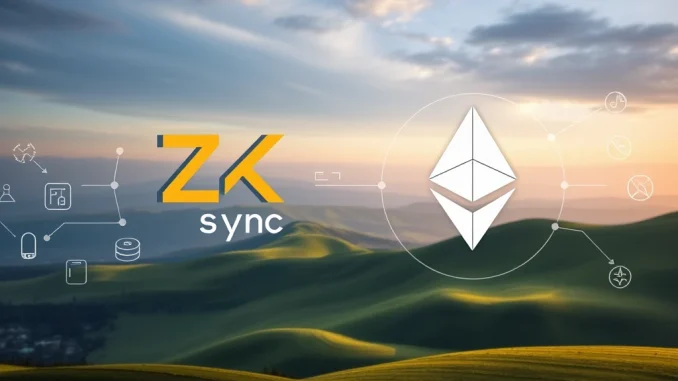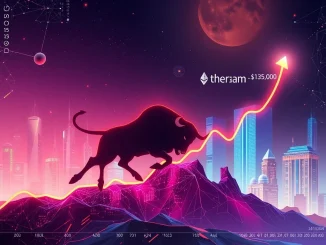
Big news from the world of Ethereum Layer 2 scaling! ZKsync (ZK), a prominent zero-knowledge rollup solution, recently announced a significant milestone: achieving full EVM equivalence. This development marks a crucial step forward for ZKsync and the broader Ethereum ecosystem, promising a much smoother experience for developers looking to build and deploy applications.
What is EVM Equivalence and Why is it Crucial for ZK-rollups?
Before diving into what ZKsync’s achievement means, let’s clarify the concept of EVM equivalence. The Ethereum Virtual Machine (EVM) is the decentralized computer that powers Ethereum, executing smart contracts. For a Layer 2 scaling solution like ZKsync to be truly useful for developers, it needs to behave as similarly as possible to the Ethereum mainnet.
EVM equivalence isn’t a single state but rather a spectrum. It measures how closely an L2’s execution environment matches Ethereum’s. Different types of equivalence exist:
- **Type 1 (Ethereum-Equivalent):** Nearly identical to Ethereum, minimal changes needed. Often harder to achieve high performance.
- **Type 2 (EVM-Equivalent):** Mostly compatible with EVM bytecode, minor differences in areas like state structure or gas costs. Requires small adjustments but offers significant compatibility. ZKsync aims for this type.
- **Type 3 (EVM-Compatible):** Can compile code written for the EVM (like Solidity or Vyper), but requires significant modifications or recompilation.
- **Type 4 (Language-Compatible):** Supports high-level languages like Solidity but compiles them to a custom virtual machine. Not EVM compatible at the bytecode level.
Achieving high **EVM compatibility** or equivalence is vital for **Ethereum Layer 2** solutions because it dramatically lowers the barrier to entry for developers. Projects and teams with existing Ethereum codebases can migrate with minimal effort, leveraging their existing knowledge, tools, and infrastructure.
What Does ZKsync EVM Equivalence Mean in Practice?
According to the announcement shared on X, ZKsync’s achievement of full **ZKsync EVM equivalence** means developers can now interact with ZKsync’s network using standard Ethereum tooling without requiring specialized ZKsync-specific modifications. This includes:
- **Clients:** Standard Ethereum clients can be used.
- **Toolkits:** Popular developer toolkits work out-of-the-box.
- **Configuration Files:** Existing configuration files are largely compatible.
Crucially, developers can now deploy standard EVM bytecode directly onto ZKsync. This eliminates the previous necessity of using specialized compilers or tools like zkSolc or Foundry ZKsync specifically for the deployment process itself (though these tools still offer ZKsync-specific features and optimizations for development). This direct deployment capability is a significant boost to developer productivity and ease of migration.
Unlocking New Possibilities for Blockchain Development
This enhanced **EVM compatibility** on ZKsync opens up exciting possibilities for **blockchain development** on the platform:
- **Easier dApp Migration:** Existing decentralized applications (dApps) built for Ethereum can potentially be ported to ZKsync with much less friction, saving significant development time and resources.
- **Wider Developer Pool:** Any developer familiar with Ethereum development can now easily start building on ZKsync, expanding the talent pool available for the ecosystem.
- **Access to Mature Tooling:** Developers gain access to the vast and mature ecosystem of Ethereum development tools, including debuggers, testing frameworks, and deployment pipelines.
- **Increased Innovation:** With lower development hurdles, more teams might choose ZKsync for new projects, fostering innovation within the **ZK-rollups** space.
This move positions ZKsync as a highly attractive destination for projects seeking the scalability benefits of a ZK-rollup while retaining the familiarity and vast tooling of the Ethereum environment.
The Road Ahead for ZKsync and Layer 2 Scaling
Achieving full **ZKsync EVM equivalence** is a major technical feat and a testament to the progress being made in **Ethereum Layer 2** scaling. While ‘Type 2’ equivalence still involves some minor differences compared to Ethereum L1 (primarily related to gas costs and state representation optimized for ZK proofs), reaching this level of compatibility is often considered the sweet spot, balancing developer ease with the performance benefits of ZK technology.
This milestone is likely to accelerate the adoption of ZKsync among developers and users alike, contributing to the overall growth and decentralization of the Ethereum ecosystem by offloading transaction volume from the mainnet.
Summary: A Leap Forward for ZKsync
ZKsync’s announcement of achieving full EVM equivalence is a pivotal moment. By allowing developers to use standard Ethereum tools and deploy EVM bytecode directly, ZKsync significantly lowers the barrier to entry for **blockchain development** on its platform. This enhanced **EVM compatibility** is set to attract more projects and developers to this leading **ZK-rollups** solution, reinforcing its position as a key player in the **Ethereum Layer 2** landscape and driving forward the future of scalable decentralized applications.



